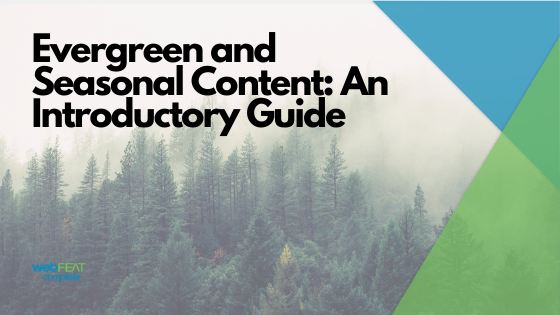In a world where posts, freebies, and blogs can make or break your online presence, it can feel overwhelming to keep up with the content demands of running a business. Fortunately, the types of content you should be publishing can be broken down into categories, and the job of curating content for your business becomes a lot easier when you can aspire to a balance of all different types. Today, we’ll be discussing evergreen content vs. seasonal content, the merits of both, and when you should be creating what.
The Basics
When a piece of content is “evergreen,” it isn’t time-bound. It’s relevant to your industry or business all the time. Often, this is content that addresses frequently asked questions that go along with your product or service. It can be shared any time, updated occasionally when new information presents itself, and will generate value over time.
Seasonal content, on the other hand, is what you would expect to be the natural opposite. The relevance of this kind of content decays quickly, and wouldn’t be the best for re-purposing or re-posting. However, in the fast-paced world of online conversation, seasonal content ensures that your brand has a seat at the table when it comes to discussing current events in your industry and culture at-large.
The Benefits of Evergreen
- Evergreen content won’t expire, so you don’t have to worry about updating it. Say you wrote a seasonal piece predicting trends in 2010 that turned out to be wrong. In the off chance that someone stumbles upon it, they could end up with a negative impression of your brand.
- Evergreen content could hypothetically be worth more money. Imagine a written piece of content earns a value of $1 per week. The evergreen piece of content will earn that $1 every week, every year for the foreseeable future, or $52 a year with no cap to its growth. Seasonal pieces won’t have the same ROI (with your investment being your time) because they have a shorter half-life.
- Evergreen content is easier to create–and probably more fun, too. Since the information is static and always available, you can take your time creating a useful, thorough piece of content, without having to worry about being one of the first brands to enter the conversation. There will be plenty of sources for research, and because the content will deal with something that is core to your industry, you’ll probably enjoy getting to share your expertise!
Examples of Evergreen Content
- FAQs
- Case Studies
- Industry history
- Basic concept explanations
- Original research
- How-To guides
The Benefits of Seasonal Content
- Seasonal content keeps you top of mind, and can show you care. Publishing seasonal content proves that your company is living “in the moment” and paying attention to what’s happening around it. For example, an article about the importance of heatwave safety as summer approaches shows that you’re trying to respond actively to present customer needs.
- There’s less competition. Since evergreen content is easier and hypothetically more valuable, many businesses opt for an evergreen-only strategy. Plus, when you right about time-bound topics specific to your industry, there are going to be less voices in that conversation based on how narrow your niche is.
- News and fads get attention, and could drive a quick burst of traffic to your site. Publishing a piece of news will generally appeal to an audience more than publishing a topic they’ve seen hundreds of times already. News and seasonal pieces have a natural tendency to stand out, giving you more value upon initial publication.
Types of Seasonal Content
- Responses to relevant news stories, fads, or industry happenings
- Holiday, anniversary, or special event highlights
- Limited time sales, product offerings, or promotions
- Campaigns based on internet trends
So there you have it, the basic concepts behind evergreen and seasonal content. When you account for this content marketing dichotomy, you can ensure that your strategy is working the way it needs to. Organizing your content calendar becomes a little less stressful when you try to achieve a balance, and by doing so, you’re staying in your customer’s mind while adding value to their lives and participating in the conversations that matter to them.
What’s on your content calendar for 2020? How much is evergreen, and how much is seasonal? If you’d like some direction figuring that out, give us a call. We’re ready to help you have your best year yet!

